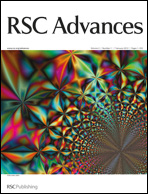Light–thermal conversion organic shape-stabilized phase-change materials with broadband harvesting for visible light of solar radiation†
Abstract
To achieve highly efficient utilization of sunlight, organic shape-stabilized phase change materials (OSPCMs) with light–thermal conversion and visible light (solar radiation) harvesting abilities were designed and synthesized through color matching (yellow, red, and blue) according to the solar irradiation energy density. These materials exhibited excellent rapid and broadband visible light-harvesting, light–thermal conversion, thermal energy storage, and form-stable (remained in the same state upon transition) effects. The chemical structures of OSPCMs were verified using Fourier transform infrared and


 Please wait while we load your content...
Please wait while we load your content...